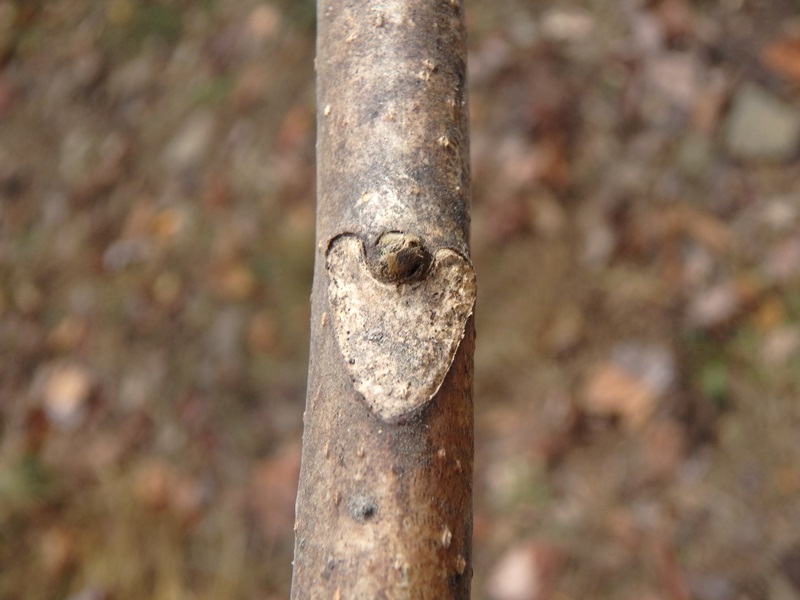Mariton: Tree of Heaven Clones
by Tim Burris, Preserve Manager
Tree of Heaven (Ailanthus altissima) is another cloning tree species. (For some reason, my colleagues and I just refer to this tree simply as Ailanthus. No common name, no species.) This is a non-native and very invasive tree. Like other cloning species it produces a lot of seeds, and spreads its roots underground sending up shoots. It also does well in a variety of disturbed habitats like other cloning species. It can be distinguished by other similar looking trees (sumac, black walnut, etc.) by smelling the leaves. I have always felt the leaves smelled like ‘burnt or rancid peanut butter’. It has a very characteristic smell and can’t be confused with any other similar looking leaf. (Dr. Sakai always stressed using our other senses to help identify trees.)

Ailanthus leaf scars are very characteristic in the winter.
It is one of those plants that preserve managers (myself included) downright hate. From our standpoint, there is nothing heavenly about this tree. It is the Hydra of invasive plants. If you cut one stem or damage the parent tree, it will send out a dozen more shoots. You can never win if you try to eradicate it just by cutting. Managing this tree requires some surgical chemical therapy. The sap can also be caustic to tree workers when they chip living trees. (A reflection of my disdain for this species is that I didn’t have single photo in my files. You can see leaves and other parts of the tree here.)
Just before I started working at Mariton, Polly Ivenz had boy scouts girdle a small grove of Ailanthus trees where the Turnpike Trail begins. This was nearly 30 years ago and before we fully realized how best to manage this tree. The result was that those 40 trees quickly became 120 established trees. It took the next 20 years for me to bring those clones under control. It was a long continuous process, but I had most of the shoots eradicated by 2012. You may remember that in 2012 Hurricane Sandy blew through, and it knocked over a swath of trees in that area. Fortunately, I had the Ailanthus under control by that time. Otherwise, I would have had to start all over again. Since Hurricane Sandy I have been able to work through the area addressing random shoots as they appear.
As stated in an earlier Field Note, Ailanthus seems to be the preferred host plant for the adult stage of the Spotted Lanternfly. Ailanthus trees grow along every highway, in every quarry, and in vacant lots. I think that controlling the Spotted Lanternfly will be a long and arduous process, with a lot of missteps along the way – just like managing the Tree of Heaven.
For “a few” decades I’ve been observing and thinking about what happens after disturbances. Disruptions can be caused by nature, or humans. I have come to the belief that planting NATIVE clone species after a disturbance is a powerful tool to deal with the non-native invasive plants that are likely to invade. Trees like aspen, sumac and pawpaw grow quickly both above and below ground, and don’t mind played out soils. They can shade out other plants and take up space in the soil. For thousands of years these trees have been “invading” the landscape after glaciers, floods, fire and the plow. (Dad always referred to them as ‘weed trees’.) That makes them the ideal species to be the foundation of an aforestation program. As I said earlier, I had planned to plant aspen and sumac after Hurricane Sandy. The sumac moved in on its own and Tuliptrees (Lireodendron tulipifera) popped right up from seeds and stumps. So, I didn’t need to plant trees after that disturbance. Clones have some cool attributes, and for resource management they are another tool in our tool box. I can’t think of a better way to fight an invasive like Ailanthus than to plant a native invasive like aspen or sumac.
